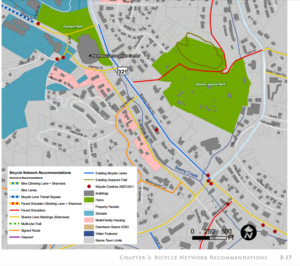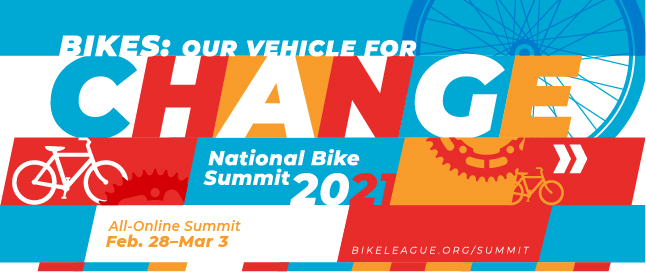Please save November 3-6 for this year’s BikeWalk NC Summit, then take 2 minutes to provide some important information about your travel and convening comfort level and expectations.
The League of American Bicyclists’ National Summit
Pre-Summit Social and Q&A on E-bikes and Cargo bikes with Arleigh Greenwald
Arleigh Greenwald is the owner of Bike Shop Girl Bikes in Aurora, CO. A mom and life long bike industry employee with over 18+ years as a professional mechanic, she has guided many in their purchase of a cargo bike and inspired countless others to “bike more and worry less,” (a philosophy we can all relate to these days). She has a deep desire to make our communities healthier, happier, and less congested as she watches her own children grow up. You can see several of her reviews of cargo bikes at the website bikeshopgirl.com. Arleigh is passionate in believing that ADHD, obesity, transportation gases, and much more can all be helped with a simple bike ride and choosing to #LeaveTheCarAtHome. Grab a beverage, come say hello to everyone, and bring your questions for Arleigh on Weds., November 4. We’ll start gathering at 5:30 pm ET, and Arleigh will join us at 6 pm.
How inclusive is Public Transit for those with disabilities?
How much support is given to non-car forms of transportation in our state?
Before NCDOT’s current financial woes, in 2018-2019, North Carolina’s Department of Transportation had a budget of $5 billion dollars.
From NCDOT’s $5 billion budget, public transit’s share was only $124.5 million for the entire state, which has 90 transit systems. (Note: many of the budget decisions for how NCDOT can spend money come not from NCDOT but from the General Assembly.) This lack of serious financial support makes it impossible to have the type of transit systems that communities ask for.
People often say they don’t take the bus because of the amount of time it takes over driving. Would it be different if buses had more funding, dedicated lanes, and more input from those who depend on them most? And what does the amount of money given to transit say about how our state values those who cannot drive or don’t have access to a car?
The Summit will have a panel discussion that will address several issues related to mobility as it impacts people who are blind or visually impaired or otherwise disabled. With advances in technology, changes in the ways people get around and aging Baby Boomers, increasing numbers of people with disabilities are out and about and engaging in society on all levels. The need for transit and transportation services and infrastructure which will allow for safe and effective travel for school, work, healthcare, social and cultural interactions and engagement has never been more important to the growing community of people with disabilities.
This session will spotlight the needs of those for whom transit is not just an alternative to driving, but a main part of their independence and mobility.
UPDATE: You can watch the discussion below:
Revised Budget Language Fixes Bicycle and Pedestrian Planning Grant Provision
 The Conference Committee’s released budget (here) has replaced the original Senate budget provision with an annual progress reporting requirement. The original provision would have decimated the NCDOT’s Bicycle and Pedestrian Planning Grant program by requiring a pay-back of grant funds if projects weren’t implemented in a timeframe over which they had limited control. See here for a previous discussion of the potential impact of the provision, especially on small, rural towns.
The Conference Committee’s released budget (here) has replaced the original Senate budget provision with an annual progress reporting requirement. The original provision would have decimated the NCDOT’s Bicycle and Pedestrian Planning Grant program by requiring a pay-back of grant funds if projects weren’t implemented in a timeframe over which they had limited control. See here for a previous discussion of the potential impact of the provision, especially on small, rural towns.
We identified the concern – that funding plans that just sit on a shelf without project implement is a waste of tax payer money. We agree and want to see bicycle and pedestrian infrastructure built, not just planned. After speaking with NCDOT staff and with transportation planners across the state, the problem is not the planning grant program. The grant application process is very competitive and the winnowing process ensures that the most motivated and committed localities are accepted into the program. These communities very much want to get projects built and avail of the many benefits of active transportation.
However, the timeframes for all transportation projects is very long and not in the control of the local entity, therefore imposing a six-year implementation window for bicycle and pedestrian projects (and no other mode) is unrealistic and unfair. After developing the plan (typically 2 years for bicycle and pedestrian plans to be developed and adopted by the community), the state prioritization programming process alone can take in typical situations 8 to 15 years, or longer, from the time of project submittal. If the project scores well enough to be funded, the state provides the 20% local funds to match the 80% federal funds for all other transportation modes except bike and pedestrian projects – leaving the local government the added burden (time and financial) to obtain the local match funds.
Therefore, the original provision would have presented a deterrent to communities (a looming financial risk of repaying the grant), especially for small rural communities that most need these planning grant funds. Here is our response to the concern in more detail.
We would like to thank the legislative leadership for listening to us and others to fix this provision. By requiring NCDOT to report annually on project implementation in plans funded by their grant program, we hope to see more focus on bicycle and pedestrian infrastructure. These projects are typically part of an economic development or safety improvement strategy. The benefit of requiring NCDOT and towns to reflect on their plans at least annually will likely be to better identify barriers to implementation that we can all work together with the legislature to remove.
One obvious barrier is funding for the required local match that is provided by the state pursuant to the state’s Strategic Transportation Investment law for all other modes except bicycle and pedestrian projects. This year’s budget contains an increase in funding for most modes of transportation, much from the General Fund, but does not include an increase for bicycle and pedestrian modes. We are hopeful that this reporting requirement means that the legislature is interested in seeing more bicycle and pedestrian infrastructure built and we want to work with them next session to make this happen.
